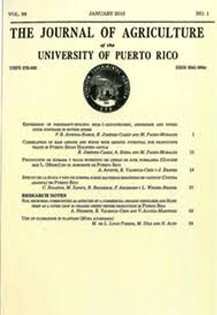Abstract
Sustainable agriculture requires crop rotation and legume cover crop associations to increase organic matter and reduce inorganic fertilizer use. In this study, three experiments were conducted to evaluate the effects of crimped legumes (CL) using dwarf velvet bean (Mucuna pruriens) and sun hemp (Crotalaria juncea 'Tropic Sun') versus conventional planting (CP; plowing and disking) on ear yield and size, insect damage and seed yield of sweet corn [Zea mays(L.)' Suresweet 2011']. Experiments were conducted in April and July 2013, and February 2014 at the Isabela Agricultural Experiment Station (Puerto Rico) on an Oxisol. Greater biomass (DM) and nitrogen (N) contribution were found in the July (summer) planting, where dwarf velvet bean produced 1.66 Mg/ha DM and 45.5 kg/ha of N compared to 'Tropic Sun' with 0.96 Mg/ha DM and 26.33 kg/ha of N. This difference was possibly related to the photosensitive responses of CL. Contrast analysis between CL vs. CP and dwarf velvet bean vs. Tropic Sun showed no significant differences on ear yield and marketable yield seed in the April planting. However, for the July planting, dwarf velvet bean surpassed (P<0.05) 'Tropic Sun' by 4.09 Mg/ ha on ear yield and 2.57 Mg/ha on marketable seed yield. In the February planting, ear yield was better (P3.63 Mg/ha) than in CL. Ear corn damage caused by Helicoverpa zea averaged 1 to 2 cm and was not significantly different among the three planting dates in the three systems. Despite the differences in yields with seeding systems, dwarf velvet bean yields were uniform across planting dates.Downloads
Download data is not yet available.

